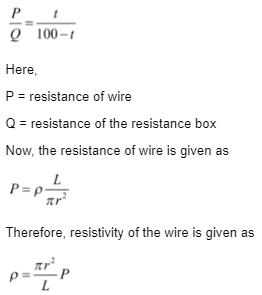As the electrons move through the wires, they encounter some kind of obstacle in their way. Resistance is the obstruction or impediment to the flow of charge. When an electron moves from one terminal to another terminal, its path is not direct. In fact, it is a deflected path involving several collisions found with constant atoms inside the conductor. The electrical potential built up between the two conductors stimulates the charge, it is the resistance which discourages or interrupts it.
Specific Resistance
The specific resistance or resistivity of a material is defined as the resistance offered by a 1 m wire of the material that is 30 cm long. There is a close connection between the resistance and the specific resistance of a material. The resistance of a cable is proportional to the resistivity or specific resistance of the material.
Electrical resistivity is the electrical resistance per unit length and unit area of cross-section at a given temperature and is represented by ρ. Electrical resistance is also referred to as a specific electrical resistance. Electrical resistivity unit is ohm meter.
Resistivity Formula
The resistivity formula is used to determine the resistivity which is given as

The specific resistance of thick wire increases and it decreases for the thin wire because the cross – sectional area is less for thin wire. The specific resistance of wire increases when the length of the wire is decreased. The specific resistance or resistivity of wire decreases when the length of the wire is increased.
Resistivity of Various Materials
Material having high resistivity has high resistance and resist the flow of electrons. And the material with low resistivity has low resistance and therefore the electrons can flow smoothly through the material.
For example, the resistivity of copper and aluminium are low. Good conductors have lower resistivity. The resistivity of Insulators is high. The resistivity of semiconductors lies between the resistivity of conductors and the resistivity of insulators. Gold is a good conductor of electricity and thus gold has a low resistivity (specific resistance).
Glass is a good insulator that does not allow the flow of electrons. Therefore, it has a high specific resistance. Silicon is a semiconductor and therefore enables partial movements of electrons. The resistivity of silicon is between glass and gold. The specific resistance of a perfect conductor is zero (0) and infinite for a perfect insulator.
Specific Resistance of Materials
Tungsten = 33.2
Copper = 10.8
Gold = 14.7
Pure Iron = 60.0
Magnesium = 276
Silver = 9.8
Meter Bridge
A metre bridge is also called a slide wire bridge. Meter bridge is an instrument which works on the principle of Wheatstone bridge. It is used to determine the unknown resistance of a conductor.
A meter bridge is a type of Wheatstone which uses an electrical circuit for measuring an unknown electrical resistance with balancing two legs of the bridge circuit, where one of the legs contains an unknown component.
Samuel Hunter Christie designed a meter bridge in 1833 and it was then improved and also simplified in 1823 by Sir Charles Wheatstone. Digital multimeters, nowadays, offer the easiest way to measure resistance. The Wheatstone bridge can still be used to measure the values of light resistance around the milliohm range.
Resistance of a wire using Meter Bridge
Following steps should be followed while determining the resistance of a wire using a meter bridge.
A wire of known length L is connected to one of the gaps (P) a counter bridge, and a resistance box is installed in the other gap (Q).
Circuit is completed with a battery (B), a rheostat (Rh), one key (K) and one galvanometer (G).
Balance length (l) is determined by closing the K key and momentarily turning on the galvanometer until it yields zero deflection (zero point).
Then, Using the expression for the balance meter bridge.

Here,
r = radius of wire and is calculated by using screw gauge
L = length of wire is calculated with a scale
Error
The most important systematic errors in this experiment are based on
- Heating effect
- Final corrections, which are introduced due to the change in zero scale at the points A and B
- Random resistance in P and Q
- And also, errors caused by the non – uniformity of meter bridge wire.
Conclusion
Electrical resistivity is the electrical resistance per unit length and unit area of cross-section at a given temperature and is represented by ρ.
The resistivity formula is used to determine the resistivity which is given as
The magnetic field in the axis of circular loop is calculated using biot savart law. The mathematical formula to calculate the magnetic field at any particular point on the axis of the circular loop of radius a and current carrying I, at a point P far from it at a distance x is given by:
The specific resistance of thick wire increases and it decreases for the thin wire because the cross – sectional area is less for thin wire.
Good conductors have lower resistivity.
The resistivity of Insulators is high.
The resistivity of semiconductors lies between the resistivity of conductors and the resistivity of insulators.
Meter bridge is an instrument which works on the principle of Wheatstone bridge.
Meter bridge is used to determine the unknown resistance of a conductor.
Using the expression for the balance meter bridge.
 Profile
Profile Settings
Settings Refer your friends
Refer your friends Sign out
Sign out






